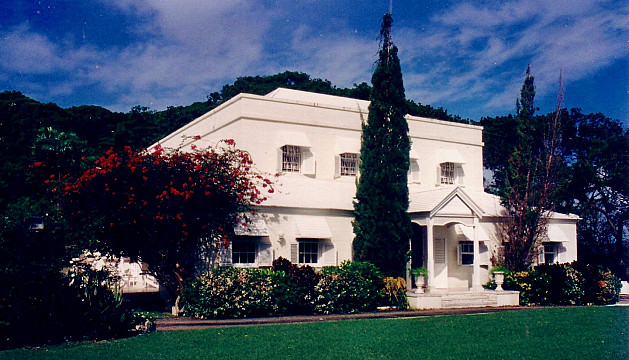Hopefield Manor
Hopefield, Christ Church, Barbados
Built circa 1831, for Mrs Mary Jane (Gaskin) Callender, the widow of Lt.-Colonel Nicholas Rice Callender (1780-1816). It is described as a 'classic Barbadian plantation house' set in magnificent gardens. It boasts an impressive Doric portico and enclosed verandahs on the north and east facades. Its been superbly restored by Sir David Seale who keeps the ground floor, gardens, stables and stud farm open to the public. It is one of the most popular of the National Trust Open House venues and neighbours Seale's Foursquare Rum Distillery, Heritage Park and Sunbury House....

In 1680, Hopefield was just a small plantation of 50-acres that sat directly on the border of Christ Church and St. Philip. At that time it was named "Boucher's" for its first owner, Captain Robert Boucher. Robert's son, Clement, left the plantation to his daughter, Mary, who married Richard Callender (1710-1766) and thus "Boucher's" became "Callender's".
Timothy Callender (1734-1800), son of Richard and Mary, was the next of the family to live here. On his death, it passed to his son, Lt.-Col. Nicholas Rice Callender (1780-1816), a graduate of Oriel College, Oxford, who was killed during the Bussa Rebellion as the risen-up slaves crossed his land. His widow, Mary, continued to oversee the running of the plantation until their eldest son, Thomas Edward Callender (1808-1858), was of an age to take it over. It was during this time that a hurricane swept across the island destroying the original house and Mrs Callender built the nucleus of Hopefield Manor as seen today.
Taking Form By Ince
Taking Form By Ince
Thomas Callender was succeeded by his son, George Gaskin Callender. By 1881, the plantation had grown to 236-acres when George sold it to James Edward Ince (1848-1908), of Adams Castle. The house built by Thomas' mother remained a fairly modest affair up until 1920. Buoyed by the sugar boom that proceeded the end of the First World War, James Ince's son, Francis Thomas Ince (1863-1943), added to it significantly: Frank (as he was known) built the grand portico with Doric columns to the north front of the house, the west wing, and then stuccoed the exterior before painting it white.
Sir David Seale and Hopefield Manor
Sir David Seale and Hopefield Manor
Frank and his wife, Ida Maury Cox (1868-1943), both died in 1943 when they were succeeded by their son Francis Herbert Biscoe Ince (1908-1975), former Manager of the Royal Bank of Canada in Barbados, and then its branch in the Bahamas. In 1971, he sold it to the present owner - well-known throughout the island - Sir David Seale, who renamed it "Hopefield Manor". The interior was decorated for Seale by Larry Van Duesen, who chose the colours specifically to bring out the profusion of antique mahogany furniture within. There are many fine ornaments on display and paintings include those by Lady Seale's sister, Joanie Skeete.
Today, the 100-acre estate encompasses the fabled thoroughbred stud farm that has produced a record 7-winners of the Sandy Lane Gold Cup (formerly the Cockspur Gold Cup). The farm is open to the public, as is Hopefield's ground floor and gardens.
Today, the 100-acre estate encompasses the fabled thoroughbred stud farm that has produced a record 7-winners of the Sandy Lane Gold Cup (formerly the Cockspur Gold Cup). The farm is open to the public, as is Hopefield's ground floor and gardens.
You May Also Like...
Categories
Share
Contributed by Mark Meredith on 04/10/2018 and last updated on 25/07/2021.
Historic Houses of Barbados (2008), By Henry Fraser & Ronnie Hughes
Connections
Be the first to connect to this house. Connect to record your link to this house. or just to show you love it! Connect to Hopefield Manor →






